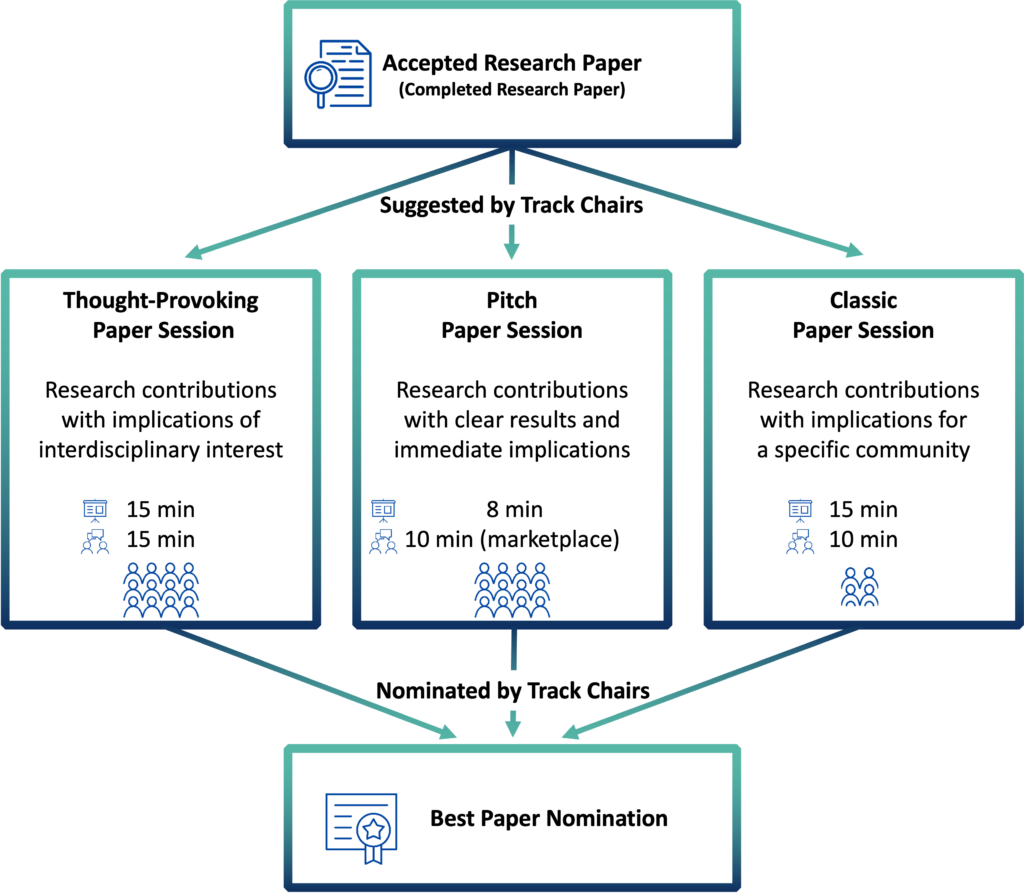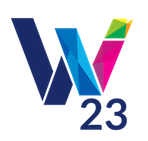Completed Research Paper
For the first time, three presentation formats for Completed Research Papers.

Completed Research Papers accepted for publication will be presented at Wi23 for the first time using three different presentation formats. As the Conference Program Committee, we want these presentation formats to facilitate communication and advancement and an interesting and entertaining presentation of the latest research in our discipline.
We should emphasize that each presentation format highlights the strengths and needs of the accepted Completed Research Papers. The Track Chairs will propose the assignment of papers based on the merits of each presentation format, while the Conference Program Committee will ultimately decide which paper will be assigned to which presentation format. The overall timing of the conference also plays a role in the final assignment. The nomination of outstanding contributions – i.e., best papers – is done independently of the three presentation formats by the Track Chairs.
The following presentation formats are intended to open further development opportunities, discussion, and dissemination of research results:
Thought-Provoking Paper Sessions
The Thought-Provoking Paper Sessions will present research contributions that have the potential to attract attention beyond the boundaries of the individual tracks and to develop more complex implications for society, theory, or management of Information Systems.
A Thought-Provoking Paper will be presented to a large audience in a 15-minute talk. In an ensuing discussion, the results and implications of the paper will be discussed comprehensively (also 15 minutes). A Track Chair or an Associate Editor will moderate this discussion. Each track may propose one Thought-Provoking Paper for this type of session.
Presentations in the Thought-Provoking Paper Sessions can be arranged in form and content at your discretion.
Pitch Sessions
Pitch Sessions will feature research papers that communicate straightforward implications and whose development is based on applying widely known research methods within a common setting.
A Pitch Paper will be presented in a 8-minute talk in front of a large audience. A discussion of the contributions will take place directly after the pitches in an interactive marketplace. The Pitch Session will intentionally be scheduled in an attractive time slot to facilitate intensive networking at the conference. Hence, for this dynamic format, the time limit for the presentations must be strictly adhered to.
For the pitch sessions, it is of particular relevance that the presentation follows a largely defined structure. The presentation should consist of a maximum of 5 slides, e.g. 1) title slide (with title, name and institution), 2) motivation slide (precise problem and motivation), 3) goal and method (research question, concise description of the methodological approach), 4) results, 5) discussion (including limitations and outlook, if applicable). The visual design of the presentation is the responsibility of the presenters. The slides for the pitch sessions will be collected centrally before the presentation so that a smooth transition between the presenters is possible.
Classic Paper Sessions
Classic Paper Sessions will present research papers that convey implications for specific communities and thus benefit from more discipline-focused discussions.
A Classic Paper will be presented in a 15-minute presentation and then discussed in a 10-minute discussion. In this way, the contribution will receive special attention from the community and will, as a result, benefit from specific and more detailed feedback for its further development. Furthermore, additional time can be spent discussing all contributions in this session. Therefore, we ask all Session Chairs to make the discussion as engaging as possible.
Presentations in the Classic Paper Sessions can be arranged in form and content at your discretion.
Research-in-Progress Paper
Requirements for the poster presentations
- For the poster presentation, posters should be provided in DIN A0 size (84.1 cm wide x 118.9 cm high) in portrait format.
- Posters should adequately reflect the content and include title, author and contact information and be written in English/German or bilingual.
- There are no specific WI23 design requirements regarding the optical appearance of the poster.
- Visual elements should be used extensively as well as clear text formatting, such as bullet points with the main findings. At least one clearly visible graphic should be used.
- A typical structure follows the structure of the research paper after a major headline, with poster sections on motivation, methodology, and results.
- The text in the body should not fall below the minimum size of 36 pt for better readability.
- The title of the RIP paper (e.g. in text size 78 pt) and the authors (e.g. in text size 72 pt) should be easy to read.
- At least one area for a QR code should be inserted at the bottom right or left corner, in the size 10×10 cm (at 300 dpi = about 1200×1200 pixels). The QR Code should be generated independently (e.g. with https://www.the-qrcode-generator.com/de/). The QR code can be used to link to a URL with a 1-2 minute video introducing the poster. The video should also be playable without sound, so subtitles or text in the video should be used here, for example. If no video is desired, the QR code can also link to a URL with the paper or to the own website.
- The poster session will be held on Tuesday, Sept. 19 from 5 to 6:30 p.m.
- Posters can be picked up at the registration desk during the entire conference period.
- Posters can be attached to your assigned board on the day of the poster session. Fixing material such as pins or adhesive strips should be brought as a precaution.
- A central pitching opportunity is planned locally. 1-2 minute videos (or the link to them, which is also referenced by the QR code) can be provided to us in advance by September 8 (at wi23@uni-paderborn.de) to be used to create a rotational presentation that we will loop on a large display at the event, but without sound. There is clearly visible numbering and a list showing when a particular video will be shown and where the poster location is.
- There is a marked area next to the display where a representative of the displayed video can independently „pitch“ the video or poster in an organized manner without a microphone.
- If you would like to have your poster printed in Paderborn, this is possible, for example, at Copypoint Paderborn (https://www.copypoint-paderborn.de/). There is no print service offered at the conference center. Printing in copyshops in the city center should be arranged in advance by appointment.
- If necessary, we can arrange a pick-up and transport service for your poster in cooperation with Copypoint Paderborn. To do so, please contact us by September 8 with the subject „Poster transport“ via the following address: wi23@uni-paderborn.de.
- You would have to check the payment with the Copyshop as we will not take care of it.
- We only take care of the transport from Copypoint Paderborn. So please make sure that you have requested this Copyshop and that your poster has been transmitted, paid and printed correctly. Only if these conditions are met, we can guarantee a pickup. Posters in the wrong format or submitted too late may not be considered.
- Be sure to include the appropriate resolution of the poster’s .pdf file to ensure the quality of the poster. We do not guarantee the layout after printing.
